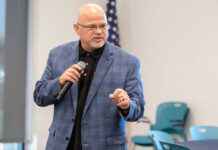The month of August is starting with a bang: not only is school back in session (parents are happy while many children are not sure!), but there are several other events that are also worthy of mention. Before I move on to those events, please join me in remembering that the start of the school year means the return of children walking to school in many parts of our communities. As you all know, school crossing zones are clearly marked: there’s absolutely NO passing in a school zone (even if there are two or more lanes in the same direction), and the speed limit is 15 miles per hour. Please keep our kids safe and drive defensively.
On Thursday, Aug. 2, some 200 people – representing Pinal’s tribal and local governments, transportation planners from Maricopa and Pima Counties, dignitaries from the Governor’s Office and the Arizona State Legislature, as well as ADOT and the Federal Highway Administration – came together to participate in the Second Pinal Regional Transportation Summit. Attendees heard presentations from our cities, towns and tribal transportation planners on their planning progress since the first Summit in Feb. 2006, followed by an address by United States Secretary of Transportation’s Acting Deputy Administrator James Ray.
The afternoon’s sessions focused on some of the non-road modalities of transportation and how we might take advantage of them as well as additional conversations about the challenges facing Pinal County (and the State of Arizona, for that matter) in funding the wide variety of transportation needs that confront us.
August is also budget and tax-rate setting time for Pinal County government. The Board of Supervisors have approved a budget for FY 2007-08 that reflects the continued demand for services in the areas of public safety, the judicial system (Pinal County Superior Court and the County Attorney’s Office), roads and the continuation of efforts in the public health arena. Although the Board adopted a tentative budget of $495M in July, the final budget adopted is $475M — $20M less than originally proposed. I am pleased to note that this budget features another year of reduction in the County’s primary tax rate: it is 29 cents less than the previous year’s tax rate. During the last two budget years, your County Board of Supervisors has lowered the tax rate by 43 cents per $100 assessed value.
Despite this good news, a frequent question this year and last year has been “why did my taxes go up?” The answer is: in Pinal County, the County’s tax rate went down (and will continue to do so) but the assessed values of property are going up. For those who own land that they live on – with no plan or expectation to convert it for development purposes – having land that’s worth more is a mixed blessing. It may mean that ultimately their estate is more valuable to their heirs in the long run, but the tax bill may be increased over the previous year’s amount. Assessed values are a function of the general real estate market and the movement of properties in the area of each parcel. The Pinal County Assessor’s Office is responsible for tracking those assessed values.
As many of you know, the County Supervisors controls only 28% of a landowner’s tax bill – the balance of the tax bill is controlled by local school districts (47%), Central Arizona College (12%), and other entities such as CAVIT, cities and towns’ property taxes, CAWCD, fire, flood or electric districts, etc. (13%). The County Board of Supervisors is required by state law to adopt the tax levies for those other, local governments but it does so upon the recommendations of those local taxing entities. For a graphic explanation of your tax bill, please go to www.co.pinal.az.us and click on the Tax Distribution Information – Where Do My Taxes Go link for more information.
In addition to this month’s Regional Transportation Summit, the Governor’s Rural Development Conference takes place in Tucson in mid-August, and I’ve been asked to be part of a panel presentation on the variety of developments taking place in Pinal County as well as some of the exciting prospects for rural development as the CANAMEX Corridor concepts unroll.
On Saturday, Aug. 18, everyone is invited to Peart Park in downtown Casa Grande to take part in an event to celebrate, commemorate and thank our Native American Code Talkers who ultimately made a United States victory in World War II possible. Code Talker Samuel Tso will be present to take part in the ceremonies – featured speakers will also be Gila River Indian Community Governor William Rhodes, Casa Grande Mayor Bob Jackson and others. I hope to see you in Peart Park at 8:30 on Saturday morning, Aug. 18.
By way of closing this month’s column, I’d like to invite everyone interested in our County’s future to do two things: 1. If you haven’t already read The Future at Pinal document, then please visit your local public library to read it there or log onto www.co.pinal.az.us and download your own copy for reading at home; 2. Consider taking part in the revision process for the County’s Comprehensive Land Use Plan – there’ll be more than 100 public meetings during the next 12 months, and your participation is critical. For a complete schedule of meetings, events and other related documents related to the Comprehensive Plan process, please go to www.PinalCountyPlan.com. And remember, The Future at Pinal document is a starting point for discussion and not a definitive rendition of the future … the future remains what we all make of it, so please become involved!














![Alleged car thief released without charges Phoenix police stop a stolen vehicle on April 20, 2024. [Facebook]](https://www.inmaricopa.com/wp-content/uploads/2024/04/IMG_5040-100x70.jpg)
![Locals find zen with Earth Day drum circle Lizz Fiedorczyk instructs a drum circle at Maricopa Community Center April 22, 2024. [Brian Petersheim Jr.]](https://www.inmaricopa.com/wp-content/uploads/2024/04/PJ_3922-Enhanced-NR-100x70.jpg)
